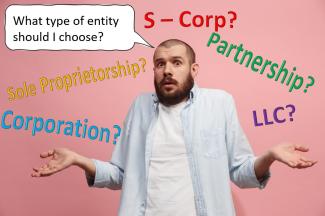
Small Business Owners: Choosing the Right Entity Structure
If you’re a small-business owner, or thinking about becoming one, then you’re in for a treat.
As a small business ourselves, we can tell you first-hand that entrepreneurship is an exciting journey, but it also comes with some unique challenges. One of those challenges, and one of the more important decisions you’ll face as a small-business owner, is choosing the right entity structure to match your current situation and future aspirations.
The type of business entity structure you choose will have an impact on how you’re compensated, how you’re taxed, how much personal liability you face, and how you raise capital. Due to the importance of this decision, Bowers Private Wealth Management (BPWM) strongly encourages you to seek the professional guidance of a financial planner and certainly a tax professional.
As a financial planning firm who specializes in working with small-business owners, we’ve seen first-hand how this decision can have long-term implications, so it’s essential to choose the right business entity structure from the start.
A business entity structure is the legal framework of the business, and determines how your business is taxed, the distribution of profits, and the amount of personal liability you may face. Each structure bears its own advantages and disadvantages, so the right choice for you will depend on your own unique goals and circumstances, both now and down-the-road. A brief description of the common types of entity structures follows, including some potential pros and cons to consider.
- Sole Proprietorship – This is the most basic entity structure and the simplest to establish. This is only available for businesses with a single owner (or married couple if filing jointly). All decision-making, profits, expenses, taxes, and liability flow through directly to the owner. While this is the easiest and cheapest to establish, there’s no tax-sheltering or liability protection, and it may be difficult to raise capital.
- Partnerships – These are similar to sole proprietorship, but with multiple owners. They’re relatively cheap and easy to establish, and all the decision-making, profits, expenses, taxes, and liability flow through directly to the owners (partners). All taxes and expenses flow through directly to the partners, and there is no liability protection, so your personal assets could be in jeopardy if the partnership, or a partner, acts inappropriately. More capital is available with multiple owners funding the partnership, and multiple owners might help reduce the risk of being over-worked.
- Limited Liability Companies (LLCs) – Laws for LLCs are governed by individual states, so they vary depending on location. In general, LLCs can have one or multiple owners. You have the option to have the profits and taxes be realized at the entity level, or they can flow through to the owners. This can be established in the Agreement. LLCs do provide limited liability protection for their members, meaning that an individual’s assets outside of the LLC are generally safe from lawsuits and creditors. LLCs are slightly more complex and costly to establish than partnerships or sole proprietorships, and generally require registration to do business in other states.
- S Corporations – These are similar to LLCs, but have their own unique restrictions and benefits. There can be a maximum of 100 members, and they must each receive a salary and pay Social Security and Medicare taxes. S Corps do allow for dividends to be paid out to members, which isn’t classified as income, so the SS and Medicare taxes are avoided. They also provide limited liability coverage similar to LLCs. S Corps are a bit more complex, and have special restrictions and regulations to offset some of the additional benefits. It’s important to discuss the pros and cons with your financial planner and tax professional.
- Corporations – These are generally the largest and most complex business structures. Corps offer maximum liability protection, and provide the most access to capital through stock and debt issuance. Decision making is done by the board of directors and officers. Income, taxes, and expenses are all realized at the corporate level. One major drawback to this is double taxation, where the corporation is taxed on earnings, and all shareholders are taxed on their proceeds. These are also generally the most expensive and the most regulated type of business.
As you can see, the way you structure your business will have a lasting impact on how your business is run, your income potential, your tax liability, and the protection of your personal assets. While it may not be the most fun decision to make when starting or running a business, it certainly is an important one. Due to the importance and complexity of this decision, we strongly recommend that you seek professional guidance through this process.
At BPWM, we work with many small-business owners to help provide education and guidance during their decision-making processes. We work closely with their tax professionals, and/or consult with tax professionals in our network to provide as much insight and guidance as possible for your unique situation. That’s just one of the many services we offer with our tax-focused comprehensive financial planning.
Visit BowersPWM.com, email clientservices@bowerspwm.com, or call our office today at 984 – 308 – 1908 to learn more about our services and schedule your free, no-obligation Introductory Conversation. You can also sign up for our free newsletter to receive periodic educational content directly in your inbox.
|
Mastering Cash Flow Management: A Key to Small Business Success |
– Next Blog |
Previous Blog – |
Empowering Small-Business Owners: Building Retirement and Financial Confidence |

